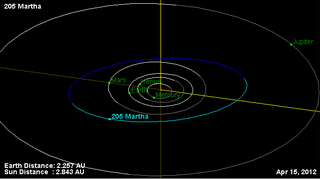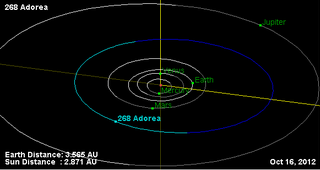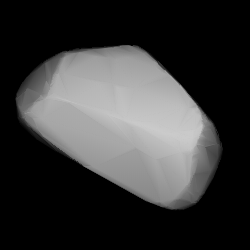
205 Martha is a large main belt asteroid. It is a dark, primitive carbonaceous C-type asteroid. This object was discovered by Johann Palisa on 13 October 1879, in Pola and was named after Martha, a woman in the New Testament.
252 Clementina is a large main belt asteroid that was discovered by French astronomer Henri Joseph Anastase Perrotin on 11 October 1885 in Nice, France. The origin of the name is not known.

268 Adorea is a very large main belt asteroid, about 140 km (87 mi) in width. It was discovered by A. Borrelly on 8 June 1887 in Marseilles. This asteroid is a member of the Themis family and is classified as a primitive carbonaceous F-type/C-type asteroid. It is orbiting the Sun at a distance of 3.09 AU with an orbital eccentricity (ovalness) of 0.14 and a period of 5.44 yr. The orbital plane is tilted at an angle of 2.44° to the plane of the ecliptic.

269 Justitia is a fairly sizeable main belt asteroid around 50 km in diameter.

316 Goberta is a mid-sized Themistian asteroid that was discovered by French astronomer Auguste Charlois on 8 September 1891 in Nice.
492 Gismonda is a main belt asteroid discovered by German astronomer Max Wolf in 1902. Gismonda is named after the daughter of Tancred, prince of Salerno, from Giovanni Boccaccio's work, The Decameron. It is orbiting 3.11 AU (466 Gm) from the Sun with a period of 5.49 yr and an orbital eccentricity (ovalness) of 0.18. The orbital plane is inclined at an angle of 1.6° to the plane of the ecliptic.

497 Iva is a main-belt asteroid orbiting the Sun, not to be confused with 1627 Ivar. It was discovered by American astronomer R. S. Dugan on 4 November 1902, and was named for Iva Shores, the young daughter of the family where he was staying in Heidelberg. This object is orbiting at a distance of 2.85 AU with a period of 4.82 yr and an eccentricity of 0.3. The orbital plane is inclined at an angle of 4.8° to the plane of the ecliptic.
538 Friederike is a minor planet orbiting in the asteroid belt. It is a member of the Hygiea family of asteroids.
656 Beagle, provisional designation 1908 BU, is an asteroid from the outer regions of the asteroid belt, approximately 60 kilometers in diameter. It was discovered on 22 January 1908, by German astronomer August Kopff at the Heidelberg Observatory. It is the principal body and namesake of the small Beagle cluster located within the Themis family. The C-type asteroid is likely highly elongated and has a rotation period of 7.0 hours. It was named for Charles Darwin's ship, HMS Beagle.
939 Isberga is a background asteroid from the inner asteroid belt near the region of the Flora family. It was discovered from Heidelberg on 4 October 1920 by Karl Wilhelm Reinmuth. As was his common practice, Reinmuth gave the asteroid a feminine name without reference to any specific person.
981 Martina is a carbonaceous Themistian asteroid from the outer regions of the asteroid belt, approximately 31 kilometers in diameter. It was discovered on 23 September 1917, by Russian astronomer Sergey Belyavsky at the Simeiz Observatory on the Crimean peninsula. The C/B-type asteroid has a rotation period of 11.3 hours. It was named after French historian and revolutionary Henri Martin (1810–1883).
1462 Zamenhof, provisional designation 1938 CA, is a carbonaceous Themistian asteroid from the outer regions of the asteroid belt, approximately 27 kilometers in diameter. It was discovered on 6 February 1938, by Finnish astronomer Yrjö Väisälä at the Iso-Heikkilä Observatory in Finland. The asteroid was named after L. L. Zamenhof, the creator of Esperanto. It is a recognized Zamenhof-Esperanto object.
3054 Strugatskia, provisional designation 1977 RE7, is a dark Themistian asteroid from the outer regions of the asteroid belt, approximately 27 kilometers (17 miles) in diameter. It was discovered on 11 September 1977, by Soviet–Russian astronomer Nikolai Chernykh at the Crimean Astrophysical Observatory in Nauchnij, on the Crimean peninsula. The asteroid was named after the brothers Arkady and Boris Strugatsky, two Russian science fiction authors.
1581 Abanderada, provisional designation 1950 LA1, is a dark Themistian asteroid from the outer regions of the asteroid belt, approximately 35 kilometers in diameter. It was discovered on 15 June 1950, by Argentine astronomer Miguel Itzigsohn at the La Plata Astronomical Observatory in La Plata, Argentina. The asteroid was named after Eva Perón.
2325 Chernykh, provisional designation 1979 SP, is a dark Themistian asteroid from the outer regions of the asteroid belt, approximately 23 kilometers in diameter. It was discovered on 25 September 1979, by Czech astronomer Antonín Mrkos at the Klet Observatory in the Czech Republic. The asteroid was named after Russian astronomer couple Lyudmila Chernykh and Nikolai Chernykh.
11409 Horkheimer, provisional designation 1999 FD9, is a Themistian asteroid from the outer regions of the asteroid belt, approximately 15 kilometers (9.3 miles) in diameter. It was discovered on 19 March 1999, by astronomers of the Lowell Observatory Near-Earth Object Search at Anderson Mesa Station near Flagstaff, Arizona. The likely C-type asteroid was named for American science communicator Jack Horkheimer.
3790 Raywilson, provisional designation 1937 UE, is a carbonaceous Themistian asteroid from the outer regions of the asteroid belt, approximately 12 kilometers in diameter. It was discovered on 26 October 1937, by astronomer Karl Reinmuth at the Heidelberg-Königstuhl State Observatory in Heidelberg, Germany. The C-type asteroid has a rotation period of 4.65 hours. It was named for English physicist Raymond Wilson.
1229 Tilia is a dark Themistian asteroid from the outermost regions of the asteroid belt, approximately 28 kilometers in diameter. It was discovered on 9 October 1931, by astronomer Karl Reinmuth at the Heidelberg Observatory in southwest Germany, and given the provisional designation 1931 TP1. The asteroid was named for the genus of trees, Tilia (lime tree, linden, basswood).
10241 Miličević, provisional designation 1999 AU6, is a carbonaceous Themistian asteroid from the outer regions of the asteroid belt, approximately 11 kilometers (6.8 miles) in diameter. It was discovered on 9 January 1999, by Croatian astronomer Korado Korlević at the Višnjan Observatory in Croatia. The C-type asteroid has a short rotation period of 3.87 hours and was named after hermit and amateur astronomer Don Nikola Miličević.

1542 Schalén, provisional designation 1941 QE, is a background asteroid from the outer region of the asteroid belt, approximately 45 kilometers in diameter. It was discovered on 26 August 1941, by Finnish astronomer Yrjö Väisälä at Turku Observatory in Southwest Finland. The dark D-type asteroid was later named after Swedish astronomer Karl Schalén.






